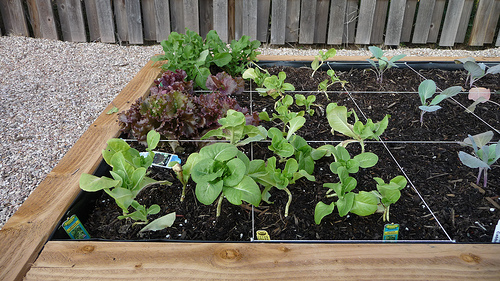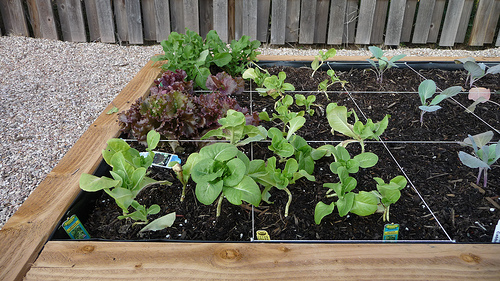Square Foot Gardens
One step up from a container garden is the square foot garden style. Square foot gardening is a simplified garden system developed by Mel Bartholemew in the late 1970’s which has gained increasing popularity throughout the United States. Being an engineer, Mel worked out a simple and very duplicable system for anyone to grow vegetables without a lot of experience, need for soil cultivation, digging or many of the other chores common to most vegetable gardens.
With square foot gardening the beds are generally laid out in four foot by four foot sections each divided into 12 inch blocks. The beds are separated by three-foot wide walking areas, and as in all raised garden beds designs, the beds are never to be walked on.
Each 12 inch block is planted with one, four, nine or sixteen plants depending on recommended spacing of seed. (12 inch spacing equals one plant per square foot grid and so on.) In this way the garden is very simple to lay out and all the guess work is eliminated.
Because square foot gardening does not use the soil in your yard or garden area, there is also no need for testing soil in this model. Instead, the beds are formed by building boxes six to twelve inches tall and four feet square and filled with “Mel’s mix” of peat moss, vermiculite and compost.
While these gardens are extremely simple and easy to grow, they do require that you build boxes to hold the garden, and that you purchase and import the soil-less growing mix. Perhaps, in one way this is another reason for their appeal; they are, essentially, expanded container gardens. However, that being said, these gardens are generally affordable and very simple, offering definite advantages to those with limited mobility or physical strength and speed to those who simply want a vegetable garden in a hurry.
Traditional Raised Garden Beds and Innovative New Practices
Those interested in a more sustainable, natural and aesthetically pleasing garden, may find traditional in-ground raised beds a more appealing garden style.
The original raised bed design, developed in France in the late 19th century, has over time been expanded and improvised upon in many forms.
These variations range from incorporating inter-planting with perennial herbs and flowers to companion planting vegetables; as well as new innovations inspired by permaculture and biodynamic systems. These variations offer gardeners a unique and varied experience in gardening along with increased vegetable production.
Innovations include natural pest controls, beneficial predators from reptile and insect species, and companion plantings. Many of these innovations have come from the permaculture movement which began in Australia in the 1950’s.
Where square foot gardening is, in its way, a miniature mono-culture system, these other styles of raised bed gardens are more diverse, interactive with the surrounding native areas, and can be as appealing to the eye and the senses as any exotic landscape garden.
French Intensive or “Double Dig” Raised Garden Beds
The original raised bed gardens of France were first implemented in the late 19th century on a two acre plot just outside of Paris. The system produced increased vegetable yields using horse manure and an intensive ‘double dig’ method which improved aeration and drainage of the soil bed. The highly aerated and loosened soil bed allowed for closer crop plantings and more intensive cultivation.
In this method the beds are ‘double dug’ by starting with a single trench at one end of the garden bed. The soil from the trench is set aside; and the soil in the bottom of the trench is further loosened with the shovel to a depth of the shovel head. This produces aeration beneath the first layer of the bed. A second trench is dug next to the first and the soil from the second trench is placed on top of the first trench. This process is repeated the length of the trench and then the final trench is filled with the soil loosened from the very first trench.
In this way the final result is a garden bed with extremely loose and well aerated soil, providing plants easy access to grow deep without encountering compaction or obstruction.
The beds are then planted very densely with vegetable plants, allowing the leaves of adjacent plants to touch when mature. This close planting provides shade to the soil beneath the plants as the season progresses and days grow warmer, further protecting the soil from moisture loss.
A typical variation on this method in use throughout the U.S. is the standard raised bed in which the garden bed is outlined and a trench dug around the outside of the bed as a walking path. The soil from this trench is layered on top of the new bed and soil amendments such as compost, rotted leaves, and manure are added to further increase the height of the bed.
Raised beds of this type tend to be approximately 8 to 14 inches higher than the surrounding ground. While these beds are typically not ‘double dug’ they do provide many of the same benefits of raised beds including earlier spring warming of the soil and the ability to more densely plant the beds.
Sheet Mulching – A No Dig Innovation to the Raised Garden Beds Method
Another form of raised bed is the sheet mulch garden, a more recent innovation which further reduces the labor and digging of earlier raised bed systems.
In sheet mulching, a practice adapted by many permaculture gardeners, the garden fork is used to open the soil by piercing the soil to the depth of the garden fork and wiggling it about a bit, then proceeding with the layering of manure, next cardboard or newsprint, then a second layer of manure, followed by compost and straw and other mulches on top. After you lay the newsprint of cardboard immediately water the entire area to keep the newsprint from blowing away while you work, and more importantly, to totally saturate the cardboard and newsprint you have laid down to speed decomposition.
Paths can be marked out around the bed or an entire area can be prepared and then the paths laid in afterwards, allowing for innovation in design and shape. The main principle of never walking on the beds is again employed and the paths are designed to provide arm’s length access to any point in the bed.
Sheet mulch designs can incorporate circles, spirals, and other more playful and imaginative shapes as they are laid free-form over the existing soil. When planting in sheet mulch beds the new plants are placed in a pocket of compost and set into the mulch down at the compost layer of the sheets, with a slit cut in the cardboard just beneath where they are planted to allow their roots to penetrate to the soil below the sheet mulch. Seeds are planted in a similar fashion by cutting a slit in the cardboard, then layering a planting bed of compost a few inches thick and planting the seeds. Each time, the mulch is brought up around the seeds or new plants just to surround and not to cover them.
This method takes advantage of the use of thick layers of mulching straw, leaves or other organic matter easily available in a given region as well as providing additional weed control through the cardboard or newsprint layering beneath the main garden surface.
Each of these methods of raised bed gardening offers different advantages and levels of difficulty to implement. It might be fun to try more than one type and see which one works best for you. But no matter which one you choose, you can always try another next year.
Many gardeners who start with a square foot garden expand to incorporate other ideas into the model as they seek to improve visual appeal, increase yields with flowering plants to encourage pollinators and other innovations. It’s your garden and you can mix and match any ideas which appeal to you.
Resources:
Getting Started with Square Foot Gardening: http://www.squarefootgardening.org/#!__get-started/vstc61=page-1
French gardening techniques and practices: http://www.frenchgardening.com/
Sheet Mulching: http://agroforestry.net/pubs/Sheet_Mulching.html



